#Carcinus maenas
Explore tagged Tumblr posts
Text
Crustaceans might put up a hard exterior, but on the inside, they may be more sensitive than is often assumed. For the first time, scientists have shown the brains of living shore crabs (Carcinus maenas) can process pain in nuanced ways, depending on the severity and location of the harm. The discovery leaves open the possibility that crabs and related crustaceans really can experience pain. And while more research is needed, that means humans who boil or cut these creatures alive could be causing undue suffering.
Continue Reading.
136 notes
·
View notes
Text
Strandkrabben-Bisque
In der zweiten Julihälfte verbrachte ich Teile meines Sommerurlaubs auf der schönen niederländischen Insel Texel. Einer der Höhepunkte war übrigens das Treffen mit dem charmanten Krautjunker Goswin am Paal 17. Goswin kommentierte dieses Foto später damit, dass er darauf aussieht wie Bilbo, der gerade von Gandalf zu einem neuen Abenteuer überredet wird… In der Hafenstadt Oudeschild amüsierte ich…
#Anders Schønnemann#Carcinus maenas#Gone Fishing: Fisch und Meeresfrüchte#Mikkel Karstad#Prestel Verlag#Rezept Strandkrabben#Strandkrabben#Strandkrabben Rezept#Strandkrabben-Bisque
1 note
·
View note
Text
Things I saw on my dive today
Anemone (no clue about the species, was brown)
Crabs, (Cancer pagurus and Carcinus maenas probably?? A few were swimming (small and orange), one was blue/black with red eyes)
Various brown/red small fish (I know basically nothing about fish so fuck knows lmao)
Sea squirts (on seaweed, clear with bluey tint)
Peacock worm (Sabella pavonina I'm pretty sure)
Sea star (Asterias rubens for sure, and larger bluey ones)
Urchins (Echinus esculentus ?)
Pipe fish (??? No idea lmao)
68 notes
·
View notes
Text

crab of the day is...
the european green crab (carcinus maenas)
fun fact: they're not really that green. bit disappointed tbh
#this is the greenest one i could find#crab of the day#im really into mouthwashing atm#crabposting#crab#wholesome#little guy#sea life#crabs#green
29 notes
·
View notes
Note
Trick or treat!
You get a green crab (Carcinus maenas)!

39 notes
·
View notes
Text
Today was the day i finally started researching for science... i think.
I had to identify each species that my advisor managed to find on a beach.
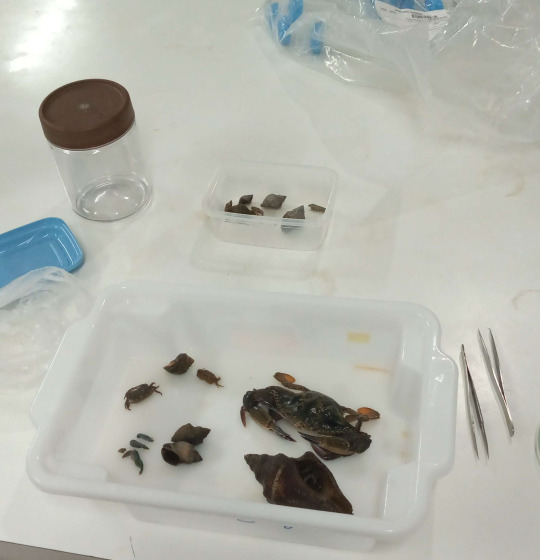
They were collected in a beach which had rocks, on low tide, so some of the species collected were actually common from reefs.
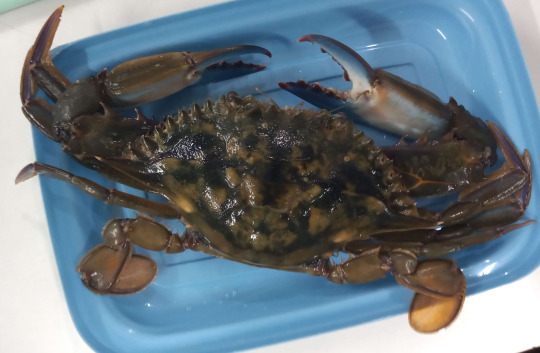
I went from the crabs first, because I thought they were the easiest ones to identify... boy i was wrong, just the brachyura identification of the coast of brazil had basically 800 pages, but this big one here was actually easier to id, because, for one, because of the slippers on their backs, they are surely what the brazilians call a "siri", so from the family Portunidae, to get the actual genre and species was a little bit tricky, basically, the males from the genre Callinectes have their telson in a T form (the book is very vague about what the hell is a T, but its their telson), you had to see little spikes they have around the eyes to determine the species, its probably a Callinectes danae
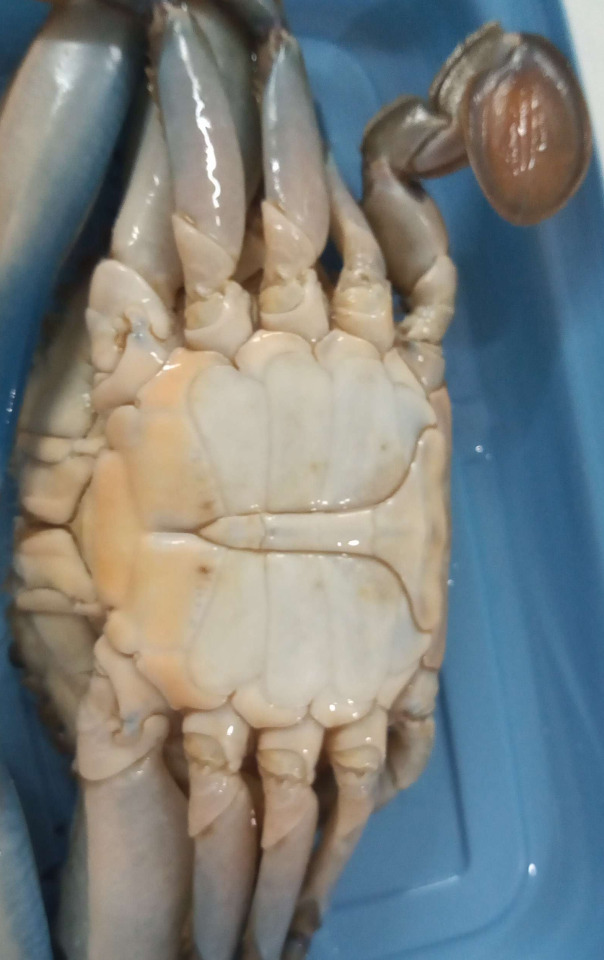
its not their penice s btw,,,
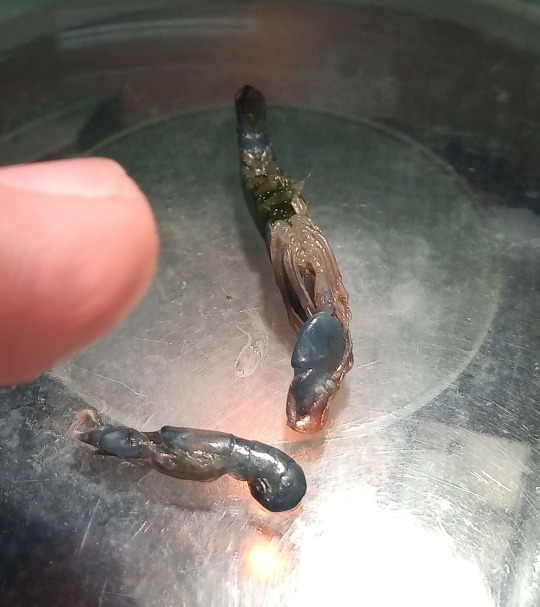
these are pistol shrimps, one of them had eggs with them, i'll have to study some Alpheidae (pistol shrimp superfamily) identifications so i can ID these ones.
The other ones were 2 Carcinus maenas and a bunch of Clibanarius crabs, that i won't show cuz they're pretty gory, because they were stuck in their shells and i had nothing to break the shells, so i had to yank them out (worst part of doing ids with crustaceans).
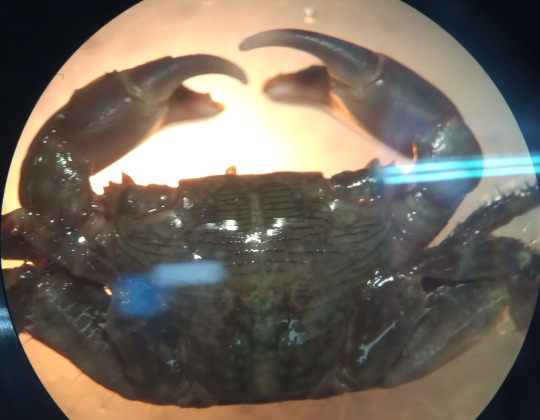
also was a pain in the ass to look cleary throught the lenses of the macroscope, so i made a sketch based on what happened
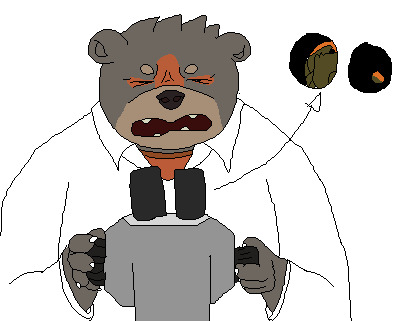
thats it....
8 notes
·
View notes
Text










18.07.24 - Young Darwin Scholarship Day 4
The bulk of today was devoted to rocky shores. We went to East Prawle where we were going to lay quadrats and collect data on the species present at the various coastal zones but as the data software wasn’t working we just explored. I couldn’t take in much information because my pain has been getting worse, I’ve been getting more and more tired and it’s been harder to think clearly, so this post will mainly just be brief descriptions of some of the things I saw and photographed.
1-2. A male European Green Crab (Carcinus maenas)
3. A lot of different seaweeds. Important information is that they are not plants and some of them, such as red seaweed, parasitise each other which is interesting. I can’t remember which species it is but one of them has bulges that look like air sacks but are in fact filled with reproductive material (I guess semen would be the closest analogue). Others do have air sacks.
4. Some sponges of which I don’t know the species - genetically and evolutionarily the closest relative of humans that can be found in a rock pool.
5. Beaded Anemone (Actinia equina)
6. Snakelocks Anemone (Anemonia viridis)
7. The ornate underside of a Cushion Star (Culcita novaeguineae)
8. Rockpool Shrimp (Palaemon elegans)
9. A Grey Seal (Halichoerus grypus) observed from a distance (getting too close stresses seals significantly). This was an interesting find. We didn’t see seals when we were purposely seeking them out on yesterday’s boat trip but we saw one today and the Grey Seal, with it’s characteristic long snout, is more rare on our coastlines than the Common Seal.
10. An out-of-focus Glow-Worm (Lampyris noctiluca), curiously not a worm but a beetle. There were several in the verges between the beach and field centre after we returned from our final evening campfire. We also detected bats on our bat detectors and saw them flying around, possibly Daubenton’s (Myotis daubentonii) as a population nests by the bridge. We also took one last chance to try and spot otters. At one point in the gloom I saw some large ripples and what appeared to be a dark shape but I don’t know if my eyes were playing tricks on me.
#personal#photos#natural history#scholarship#wildlife conservation#not so daily positives#naturalists
4 notes
·
View notes
Text
Do Crustaceans Feel Pain? Study Demonstrates Existence of Nociceptive Responses in Shore Crabs | Sci.News
See on Scoop.it - EntomoNews
Nociceptors are receptors that detect injurious stimuli and are necessary to convey such information from the periphery to the central nervous system.
Nov 26, 2024 by Natali Anderson
------
NDÉ
Traduction
Les nocicepteurs sont des récepteurs qui détectent les signaux douloureux et sont nécessaires pour transmettre ces informations de la périphérie au système nerveux central.
Les crustacés, tels que les crabes de rivage, sont largement utilisés en science et en aquaculture. Il est essentiel de savoir s'ils peuvent ressentir de la douleur pour améliorer leur bien-être. La présence de nocicepteurs est l'un des principaux critères d'évaluation de la douleur.
Dans une nouvelle étude, des scientifiques de l'université de Göteborg, de l'université d'Algarve et de l'université suédoise des sciences agricoles ont étudié l'existence de nocicepteurs chez les crabes de rivage (Carcinus maenas) en examinant la réponse du système nerveux central à deux types de stimuli potentiellement nocifs, à savoir le stimulus mécanique et le stimulus chimique ou acide acétique.
Leurs résultats indiquent que 32 zones autour du corps du crabe présentent des réponses nociceptives putatives qui répondent à un produit chimique nocif, avec de nombreuses zones présentant une sensibilité mécanique supplémentaire.
Traduit avec DeepL.com (version gratuite)
Putative Nociceptive Responses in a Decapod Crustacean: The Shore Crab (Carcinus maenas), biology, 22.10.2024 https://www.mdpi.com/2079-7737/13/11/851
Figure 1. (a) Areas on the shore crabs (Carcinus maenas) where acetic acid and von Frey hair were applied to investigate the presence of nociceptors. The tissues examined included the eyes, the antennae, the antennules, the soft tissue between the claws, and the soft tissue at the joints of the pereiopods (n = 20). (b) A schematic of the timeline of the experimental protocol and areas where acetic acid or mechanical stimuli were applied on the shore crab. Initially, animals received an injection of neuromuscular blockers. Then, after the waiting time was over for the blockers to reach a full effect, animals were transferred into the chamber where electrophysiological recordings took place (copyright: picture of a shore crab, Victorian Fisheries Authority, https://vfa.vic.gov.au/operational-policy/pests-and-diseases/noxious-aquatic-species-in-victoria/european-shore-crab (accessed on 19 September 2024)). (c) A schematic of the nervous system of a shore crab (Carcinus maenas).
0 notes
Note
Is it possible for a green crab or “shore crab” to live in full freshwater?
Hi there, are we talking about Carcinus maenas? If so, then no. Research I did a while back suggests it can tolerate down to 1.004 long term but really is best kept around or upwards of 1.010 (about half strength sea water).
0 notes
Text
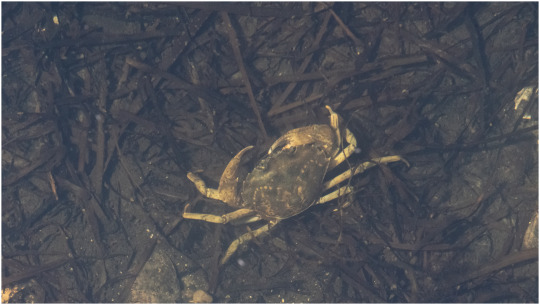
Almindelig strandkrabbe (Carcinus maenas)
Green Shore Crab (Carcinus maenas)
#Almindelig strandkrabbe#Carcinus maenas#Carcinus#Green Shore Crab#Krabbe#Crab#Portunidae#Sommer#Summer#Nibe Havn#Limfjorden
11 notes
·
View notes
Video
Voyage to the Bottom of the Sea (EXPLORED) by SkyeWeasel Via Flickr: For Macro Mondays theme 'Bottoms Up'. This shows the underside of a small shore crab, Carcinus maenas. Explored July 10, 2017.
#Macro Mondays#Bottoms Up#macro#crab#shore crab#Carcinus maenas#underside#black background#crustacean#claws#exoskeleton#carapace#arthropod#segments
4 notes
·
View notes
Photo

Beach Drama
#photography#animals#crustaceans#crab#crabs#probably a#green crab#carcinus maenas#beach#ocean#the beach#coastal#marine life#dead#death#spring#photographers on tumblr#original photography#i really liked this project from 2 years ago#i made a field guide for my local beach#nature#brown
8 notes
·
View notes
Text

The Seashore. Written by Jennifer Cochran. Illustrated by Kenneth Lilly, Patricia Mynott, James Nicholls, and George Thompson . 1973.
Internet Archive
A.) Calanus finmarchicus
B.) Larva of the shrimp Crangon crangon
C.) Larva of the barnacle Semibalanus balanoides
D. + E.) Different stages of the growth of Carcinus maenas
F.) One of the stages of Pisidia longicornis
G.) Eurydice pulchra
H.) Larva of Clytia Johnstoni
#marine life#crustaceans#copepods#shrimp#barnacles#acorn barnacles#crabs#european green crabs#long-clawed porcelain crabs#isopods#speckled sea lice#cnidarians
358 notes
·
View notes
Text

This is incredibly cool! It's a preprint so it's still undergoing peer review, but an enormous study on the terrestrialization of crabs over several stages and phylogenetic groups was just finished and there are some super illuminating findings for how crabs have evolved over hundreds of millions of years. Some of the most interesting implications are those of how invasives, like (my eternally beloathed) Hemigrapsus sanguinus and Carcinus maenas, often have the kind of traits for high habitat adaptability/tolerance that many of these common ancestors for terrestrial crab groups may have shared.
FULL TEXT check it out, it's a really awesome read!
320 notes
·
View notes
Text
Karen’s Blog, August 20 2009:
A few days ago I finally went on Cornell’s annual alumni field trip to Shoals Marine Laboratory, on an island off the coast of New Hampshire. Met a lot of nice and interesting people on the boat trip over—Hi Sue, hi Bob, Hi Louise and Stefan and Hannah, hi, Fern. We saw lots of sea birds and seals. We toured the island, watched the bird banding, visited labs, inspected some (very tidy) student dorms.
Cornell offers college-credit courses all summer; students come over for two week stays or longer. At lunch time I sat down with a bunch of students. We all started talking. The girl next to me looked at my name tag, startled, and said “Are you Karen Pryor?” Yes. She was very excited. “Your book changed my life.” Hmm. Too young for it to be Nursing Your Baby; she must mean Don’t Shoot the Dog; the new book’s only been available three weeks.
No, Lily Strassberg meant Reaching the Animal Mind, and got a jacketless and already well-used copy out of her back pack for me to sign.
Lily is 17. She has been clicker training dogs since she was ten, and now teaches public obedience classes. She read my story in Chapter 1 about training a hermit crab to ring a bell. So, for her class research project last week at the marine lab, she set out to train a crab to ring a bell. Her professor doubted it would work, but she was so excited about it, he let her try.
Lily collected some of the local hermit crabs around the island. They were very small and timid so she used the local green crab Carcinus maenas instead. (These are pointy-shelled Portunid crabs, like the blue crabs we eat on the East Coast, only of course they are green not blue.)
Lily used the same reinforcement procedure I did--feeding with forceps, using the movement of the forceps as the click. She shaped the behavior of shoving a hanging weight with a claw, an improvement over my more complicated job of pulling a string down.
Just to be safe, in spare moments across two days she trained two crabs, Crab A and Crab B, Abby and Bertha. She took good and thorough data, photographs, and video too. When she presented her project, the other students burst into applause. The professor said her study was ‘practically publishable.’ When the experiment was over, Lilly released Abby and Bertha back to the ocean in the same place where they were collected.
I was thrilled. So, apparently, were the crabs, and here’s why I think that.
For each session the crab had to be moved into a small experiment tank with a grid drawn on the floor (to measure exactly how far the crab came toward the target each time.) At first the crabs were hard to catch, and struggled mightily when lifted into the air. But soon, they got it—Oh, I’m flying to the place where I train them to feed me delicious stuff—and they just held still to be picked up by the shell, and relaxed completely in the air, legs hanging down calmly. Now I ask you: isn’t that cool? Clicker-wise ‘operant’ crabs?
What were the chances that out of 100 people or more in the room I would sit down next to Lily?
You will be hearing more about Lily, I bet.
328 notes
·
View notes
Text
Still on hiatus (senioritis is kicking my ass) but I wanted to share a bit of beach stuff


Like this pair of Atlantic horseshoe crabs (Limulus polyphemus) that I found stranded! I set them back in the water to... get back to their business.


And a female European green crab (Carcinus maenas)!

And a little American oystercatcher (Haematopus palliatus)
59 notes
·
View notes
